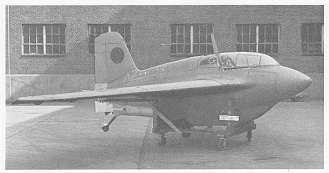Been doin sum research found sum cool stuff.
Mitsubishi J8M
The J8M was intended to be a licence-built copy of the Messerschmitt Me 163. Difficulties in shipping an example to Japan meant that the aircraft eventually had to be reverse-engineered from a flight operations manual and other limited documentation. A single prototype was tested before the end of World War II.
The J8M project resulted as a direct response to the imminent deployment of the B-29 Superfortress in 1943. The development of the US bomber was known to Japan, and it was correctly anticipated that it would be used to raid the Japanese home islands. In Germany, Japanese military attachés had become aware of the Me 163, and after a visit to the squadron evaluating the aircraft, (Erprobungskommando 16), negotiated the rights to licence-produce the aircraft and its engine.
Germany provided two set of materials consisting of technical documentation and some sample mechanical parts. These were loaded onto two submarines, however one was sunk en route. The other made it to Singapore and Eiichi Iwaya, the Navy officer in charge, flew ahead to Japan with a portion of the materials, but that submarine too was sunk near the Philippines with most of the detailed materials still on board. As a result, only a small amount of paperwork eventually reached Japan. With the first B-29 raids already taking place, it was decided to proceed immediately rather than wait for the missing material to be replaced. The fighter was assigned the J8M1 designation by the Navy and Ki-200 by the Army, the only significant difference between the aircraft being the choice of different 30 mm cannons as armament. While Mitsubishi developed the airframe, Yokosuka developed an engine based on the Walter HWK 109-509 and training gliders, the Yokosuka MXY8 (army designation Ku-13).
On January 8, 1945 glide-tests of the J8M1 commenced, pending the arrival of an engine. These were judged a success, with the ballasted aircraft performing very much like an Me 163 while gliding. The first of the Toku Ro.2 powerplants was delivered in June, and after final glide tests with the engine installed, the first powered flight took place on July 7 at Oppama airfield near Yokosuka. The take-off was normal, with the aircraft climbing away strongly, but at around 400 metres (1,300 ft), it abruptly nosed over and dived straight into the ground, killing its pilot, Lt. Cdr. Toyohiko Inuzuka. Subsequent analysis found that the fuel tank design was unsuitable for the steep angle of climb. During Inuzuka's flight, an air-bubble had been created in a fuel line, leading the engine to stop abruptly and causing the crash. All testing was suspended while modifications were made. In the meantime, Mitsubishi began mass-production of components for the aircraft. Before flight testing could resume, however, Japan had surrendered, and the war was over.
General characteristics
Length : 6.05 m
Wing Span : 9.50 m
Height : 2.70 m
Wing Area : 17.73 m²
All-Up Weight : 3,000 kg
Empty Weight : 1,445 kg
Main Engine : 1 x Mitsubishi KR10 (Tokuro-2) Rocket, 1,500 kgf (14.7 kN)
Crew : 1
Armament : 2x30 mm Ho155-II (Type 5) Machine Gun (Different varients carried more or less heat, but over all they wuz packin:cool: )
Performance
Max Speed : 800 km/h

Cruise Speed : 347 km/h
Duration of Flight : 2.5 min:cry (700 km/h)
Copyright (C) 2000,2001,2002 Free Software Foundation, Inc.
51 Franklin St, Fifth Floor, Boston, MA 02110-1301 USA
Everyone is permitted to copy and distribute verbatim copies
of this license document, but changing it is not allowed.
All of the above material can much more can be found at wikipedia.com
Oh yes and here's a pic!:aok
